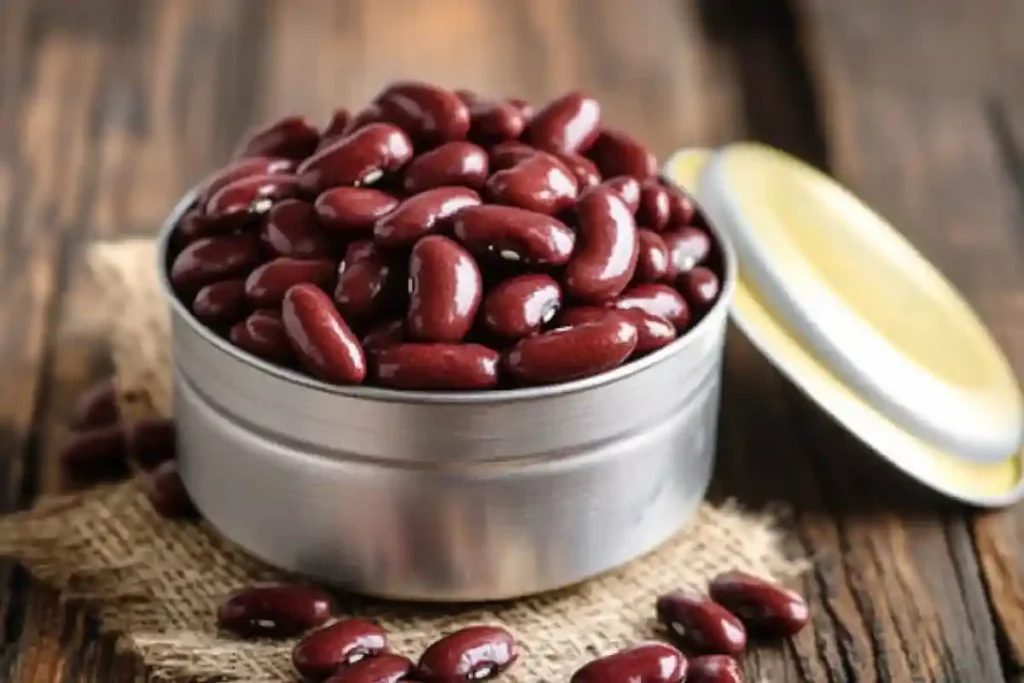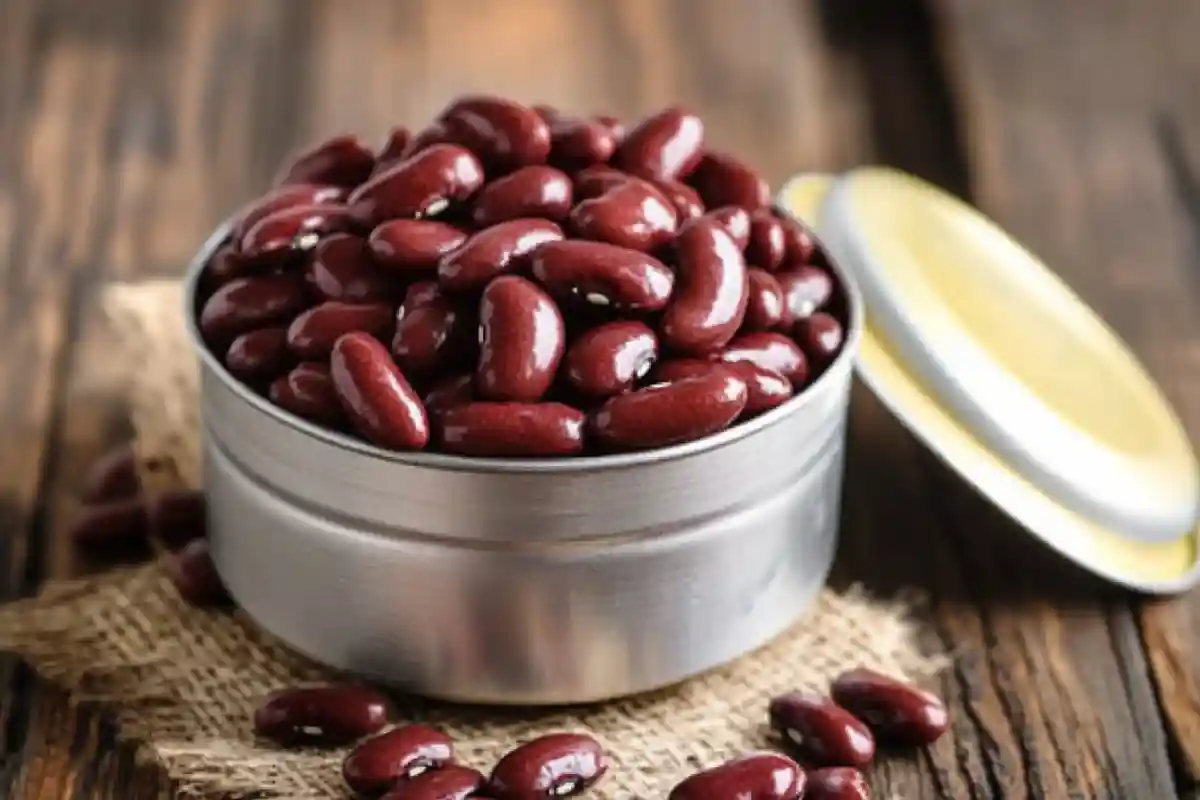
Table of Contents
Need red-beans-and-rice flavor on a Tuesday? Keeping canned red beans in the pantry slashes soak-time to zero. After three skillet tests I dialed in a brown-butter onion base, Cajun-seasoning bloom, and a 10-minute simmer that wakes up canned beans so they taste slow-cooked—without turning to mush.
What Are Canned Red Beans?
When it comes to building quick, flavorful meals, canned red beans offer an unbeatable combination of convenience and nutrition. These ready-to-eat legumes are pre-cooked and preserved in liquid, making them ideal for last-minute dinners or meal prep days. Because they’re already softened, they can be added directly to your recipes without the need for soaking or lengthy simmering.
Unlike dried beans, canned red beans cut down cooking time dramatically. You can simply open the can, rinse the beans to reduce excess sodium, and add them to your dish. It’s that simple. Additionally, they retain most of their nutritional value, offering a rich source of:
- Plant-based protein
- Dietary fiber
- Essential minerals like iron and potassium
To better understand the cultural and culinary importance of red beans, consider exploring traditional Cajun and Creole dishes. One delicious variation you might want to try is this Cajun beans and rice with sausage recipe from Flavivo Recipes. It’s a great example of how canned red beans can be transformed into a bold, satisfying meal.
Because of their texture and ability to absorb seasoning, these beans are a go-to ingredient in kitchens across the country. Not only do they work in traditional meals, but they also adapt beautifully to global cuisine—from Latin stews to Mediterranean salads.
Health & Nutrition Benefits of Canned Red Beans
If you’re aiming for flavorful meals that also boost your health, canned red beans are a clear winner. Not only are they easy to prepare, but they’re also packed with key nutrients your body needs. As more people look for affordable, plant-based protein sources, beans are becoming a pantry essential—and for good reason.
Let’s take a closer look at why canned red beans are a nutritional powerhouse:
- High in fiber, supporting healthy digestion and long-lasting fullness
- Rich in iron and folate, both crucial for blood and energy levels
- Loaded with potassium and magnesium, which aid heart and muscle function
- Inherently low in fat and free of cholesterol, making them beneficial for heart health.
- Great source of plant-based protein, ideal for vegetarians and meat-eaters alike
What makes these beans even more impressive is how they contribute to better health outcomes. For instance, a Medical News Today review highlights that legumes may help reduce LDL (“bad”) cholesterol and lower blood pressure. Additionally, their fiber content can help manage appetite and support weight control over time.
If you’re interested in combining health with bold Southern flavor, you’ll definitely enjoy exploring Louisiana dishes recipes that use beans as a base. From gumbo to jambalaya, red beans are a key part of the region’s rich culinary traditions.
Ultimately, canned red beans make it easy to cook healthy, comforting dishes at home. In the next section, we’ll walk you through how to prepare them properly so you can unlock their full flavor potential without any extra hassle.
How to Cook Canned Red Beans
Even though canned red beans come pre-cooked, knowing how to prepare them properly can make all the difference in taste and texture. Since they are preserved in liquid, it’s important to handle them with care so they blend perfectly into your dish—whether it’s a quick weeknight meal or a classic Southern recipe.
Here’s a step-by-step guide to get the best flavor out of every can:
Step 1: Drain and Rinse
Always start by draining and rinsing your canned red beans thoroughly under cold water. This step helps:
- Remove excess sodium from the canning liquid
- Improve the beans’ texture
- Reduce any metallic aftertaste
Although the liquid is safe to consume, rinsing allows you to better control your seasoning and salt levels.
Step 2: Sauté Aromatics
For deeper flavor, consider sautéing a blend of onions, garlic, and bell peppers in a bit of olive oil or butter. Once the aromatics are softened:
- Add the canned red beans
- Stir gently to avoid breaking them
- Cook for about 5–10 minutes until heated through
Step 3: Season to Taste
Because canned red beans are neutral on their own, they easily take on surrounding flavors. You can boost their richness with:
- Smoked paprika or Cajun spice
- A pinch of cayenne pepper for heat
- Bay leaves or thyme for depth
For inspiration with bold Louisiana flavor, try this Cajun shrimp étouffée recipe. It shows how beans and Cajun spices come together to create a savory, comforting dish.
Step 4: Simmer or Serve
Once seasoned, you can:
- Let the beans simmer on low for 10–15 minutes to meld the flavors
- Use them immediately in recipes like rice bowls, burritos, or hearty stews
If you prefer them creamy, mash a small portion in the pan while cooking. This adds body to the dish without extra ingredients.
Classic Red Beans and Rice Recipes
Few meals are as comforting—or as rooted in tradition—as red beans and rice. While this dish originated in Louisiana, its rich flavors and satisfying textures have made it a favorite far beyond the South. Thanks to canned red beans, you can now recreate these time-honored recipes without needing to soak beans overnight or spend hours cooking.
Even better, this dish is flexible. Whether you like it smoky, spicy, or creamy, there’s a version for every taste and skill level.
Why Canned Red Beans Work Perfectly
Because they are pre-cooked and tender, canned red beans allow you to focus on seasoning and texture rather than time-consuming prep. They also:
- Absorb seasoning quickly for full flavor
- Cut cooking time in half (or more!)
- Maintain a soft, creamy consistency with minimal effort
3 Popular Red Beans and Rice Styles
Here’s a breakdown of the most common variations of this dish, including key ingredients and flavor profiles:
| Style | Key Ingredients | Flavor Profile |
|---|---|---|
| Southern Classic | Canned red beans, smoked chicken sausage, white rice | Hearty, smoky, well-seasoned |
| New Orleans Red Beans and Rice | Holy trinity (onion, bell pepper, celery), chicken ham hock | Deep, rich, with Creole spices |
| Creamy Red Beans and Rice | Butter, garlic, bay leaf, mashed beans | Smooth, savory, comforting |
Quick Recipe: Easy Red Beans and Rice
If you’re short on time, this simplified recipe delivers big flavor fast:
Ingredients:
- 1 can of canned red beans (rinsed and drained)
- 1/2 cup chopped onion
- 1/2 cup chopped green bell pepper
- 1 clove garlic, minced
- 1/2 tsp smoked paprika
- 1/2 tsp salt
- 1/2 tsp black pepper
- 1 tbsp olive oil
- 1.5 cups cooked white rice
Instructions:
- Heat olive oil in a skillet over medium heat.
- Sauté onions and bell pepper until soft (about 4–5 minutes).
- Add garlic, paprika, salt, and pepper; stir for 30 seconds.
- Add canned red beans and a splash of water or broth.
- Simmer for 8–10 minutes, stirring occasionally.
- Serve over warm white rice.
Because this dish uses everyday ingredients and comes together quickly, it’s perfect for busy nights or meal prep.
Frequently Asked Questions About Canned Red Beans
Are canned red beans healthy?
Yes, absolutely. Canned red beans are packed with plant-based protein, fiber, and essential nutrients like iron, potassium, and magnesium. Moreover, they are naturally low in fat and contain no cholesterol, making them an excellent heart-healthy food. To reduce sodium, simply rinse the beans under cold water before cooking.
Are kidney beans and red beans the same?
Although they look similar, kidney beans and red beans are not the same. Red beans are smaller and rounder, with a slightly softer texture and more delicate flavor. Kidney beans are larger and firmer, often used in chili. However, both can be used in many of the same recipes, depending on your texture preference.
Are red beans in a can already cooked?
Yes, they are. One of the biggest benefits of using canned red beans is that they are fully cooked during the canning process. This means you don’t need to soak or boil them for hours—just rinse, season, and heat. They’re ready for use in any dish, from soups to salads.
What to do with a can of red kidney beans?
There are countless ways to enjoy red kidney beans. Here are a few simple ideas:
Add them to a pot of chili for extra protein
Mix them into a pasta salad or grain bowl
Mash them for use in vegetarian tacos or wraps
Toss them into soups or stews for a fiber boost
Conclusion: Make Red Beans and Rice a Weekly Staple
If you’re looking to simplify your cooking routine without giving up on flavor or nutrition, canned red beans are one of the best pantry items you can rely on. Not only are they budget-friendly and easy to prepare, but they also offer an incredibly versatile base for countless dishes.
Because canned red beans come fully cooked, you can spend less time prepping and more time enjoying flavorful meals. Whether you’re making a traditional New Orleans red beans and rice, a quick weeknight chili, or even a bean-stuffed quesadilla, these convenient legumes make it easy to eat well.
Additionally, incorporating canned red beans into your meals helps you stay on track with healthy eating goals. They’re packed with fiber and protein, which means you’ll feel full longer, all while keeping calories and fat in check.
Here’s why you should make them a weekly go-to:
- They cook in minutes, saving valuable time
- They blend easily into a wide variety of cuisines
- They offer a tasty way to add nutrients to your meals
- They are perfect for both beginners and experienced home cooks
Ultimately, canned red beans aren’t just a shortcut—they’re a smart ingredient choice that helps you create flavorful, wholesome meals with ease. So next time you’re planning your menu, don’t overlook that humble can in your pantry. It might just be the start of your new favorite recipe.

